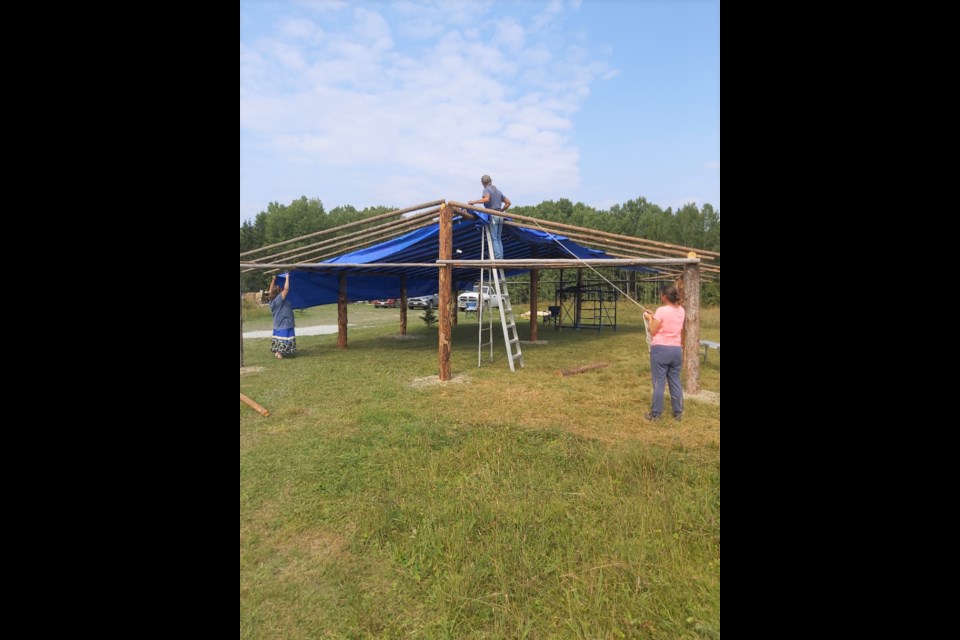A Sundance ceremony is an opportunity for people to build a healthier community and healthier relationships, says Loon Lodge member Mary Boyden.
Last week, the Loon Lodge Sundance and Rattle Child Sundance from Lac-Simon, Que., partnered to bring four days of healing, drumming and dancing to the community.
The ceremony brought Cree, Ojibway, Haudenosaunee and Inuit people together, who travelled from Quebec, Manitoba, Labrador and all over Ontario to attend the event.
The Sundance is a sacred, spiritual ceremony that lasts for four days, each year, for four years.
Dealing with issues like racism, domestic violence, losing a family member to suicide, missing and murdered Indigenous women and girls can be intense, so people require very intense healing, Boyden said.
Healing can be emotional, physical, mental or spiritual.
“That ceremony is able to touch all these elements of the human self,” she said.
Boyden runs the lodge with her partner and Loon Lodge Sundance Chief Martin Millen, who’s from Matachewan First Nation.
The preparations started four days before the actual ceremony, which lasted from Aug. 26 to Aug 29.
Many activities also happen in the following four days, and the lodge wasn't “undressed” until Sept. 2.
At the Loon Lodge Sundance, dancers started fasting the Friday before and broke the fast Sunday night. For two days before that, they helped get the lodge ready.
Throughout their two-day fasting, they danced and blew whistles as elders, children, women and men watched, listened and participated in the ceremony, too.
“This is one of the most sacred ceremonies of Turtle Island. Because it includes a lot of the other ceremonies,” Boyden said. Some of them were a horse ceremony, a children’s ceremony, a wolf ceremony, the buffalo ceremony and the tree ceremony. “That’s why it’s so intense and it takes so many people to help and make it happen.”
When the dancers go into the lodge, they commit to changing their lives for the better.
“The ceremony happens once a year, for four days, but the lifestyle we need to create takes every day of the year to make it happen. That’s why you need so many people to help because they’re all part of it,” Boyden said.
Emotions were running high when the dancers were able to leave the lodge Sunday evening and break the fast with water and slices of watermelon followed by a feast. Tears were shed and hugs were shared.
Boyden herself has experience participating in Whapmagoostui Sundance in Quebec. She said her lifestyle changed after that experience. Although she didn’t know the language, she made lifelong friends there.
“My mind learned how to think differently from being in that lodge and to see the world in a different way. To understand we all have special gifts and to choose how we use those gifts is what our journey is,” she said.
Everyone is welcome to attend the Sundance ceremony, to watch, learn and participate, Boyden said.
“Our healing is complex. We need to heal together,” she said.
The ceremony wouldn’t have been possible without the community effort.
The Bucket Shop donated a cooking tripod, Elegant Events provided the kitchen tent and the friendship centre provided cloths, medicines, and items for the giveaways.
Newmont and BK Lawn Services worked on the driveway leading to the lodge site to make it more accessible for people. The Timmins Police Service presented five large tarps, while Environmental 360 Solutions supplied the water truck, a dumpster and bathrooms.
The Keepers of the Circle workers also donated their time and energy and, working with the Ramada, paid for hotel rooms for the elders, Boyden said.
“People are really generous. I believe it has to do with reconciliation,” she said. “Canadians, in general, want to be part of the healing. And this is a really good example of how they become part the healing.”
Having the ceremony contributes to the healing of the environment in the city, Boyden said adding that the community can only be as healthy as the sickest person in the community whether it’s being sick emotionally, physically or mentally.
“We’re working on the issues that have created unhealthy relationships. We’re improving those relationships between Indigenous and non-Indigenous people,” she said. “When every member of our community gets healthier, then our community is healthier.”



